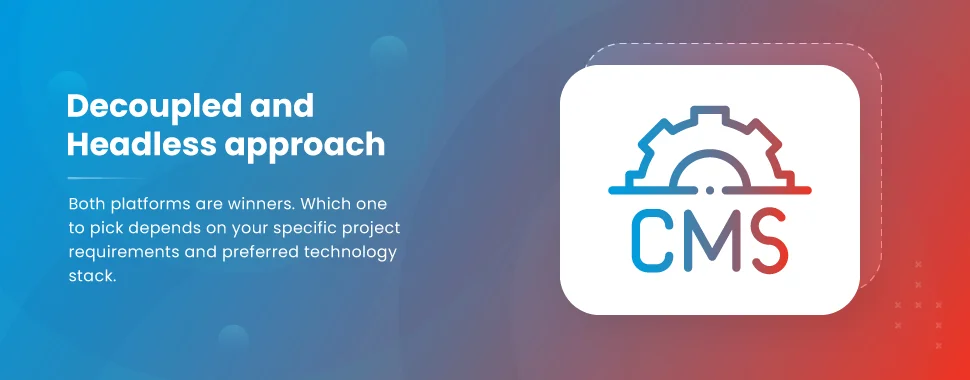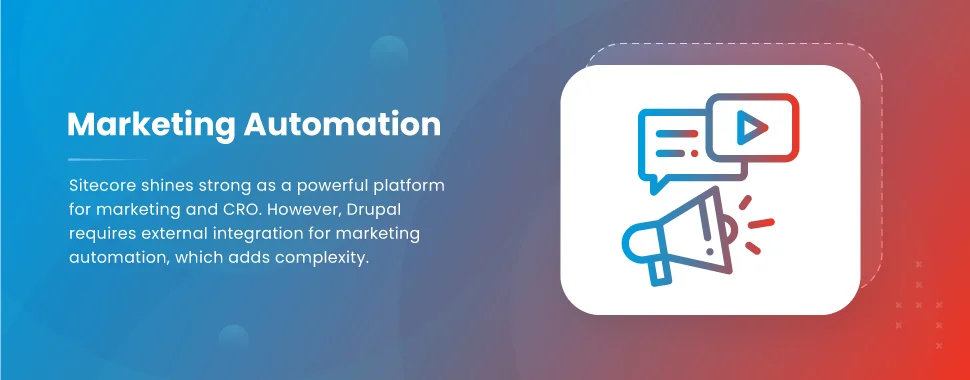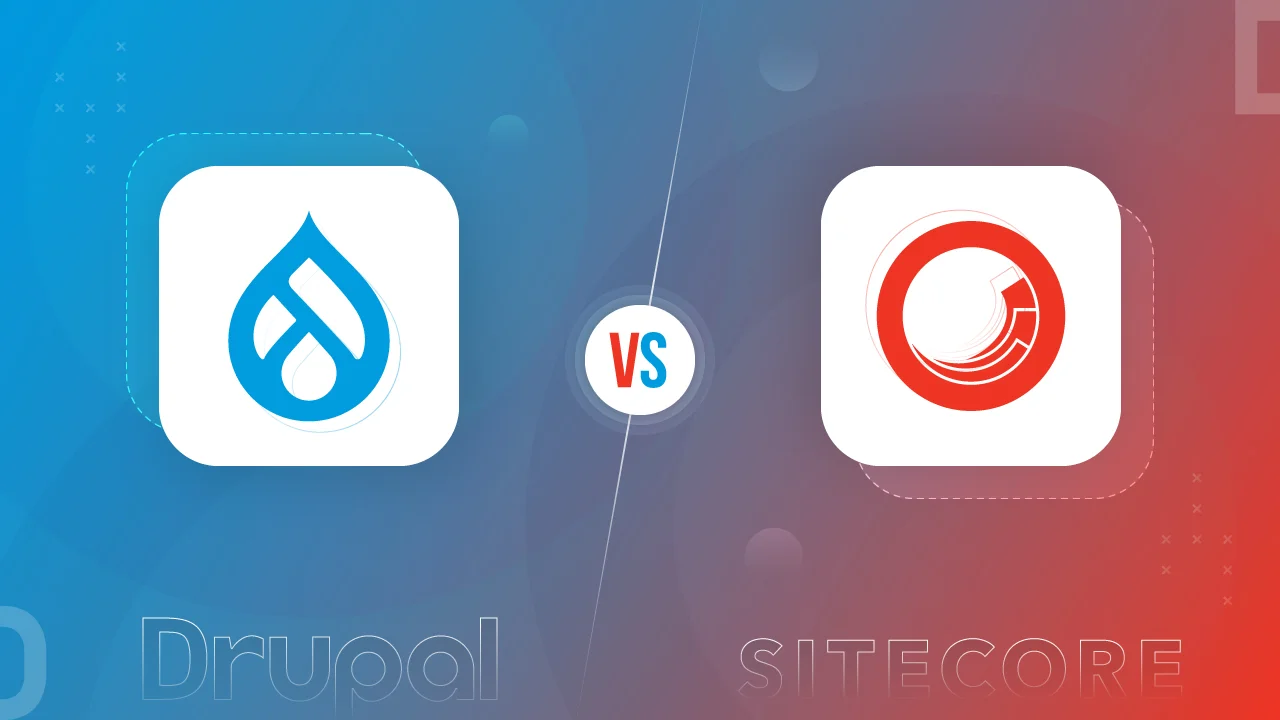Drupal and Sitecore are top-rated CMS platforms, especially for enterprises with big websites. Both of these platforms have established their names and acclaimed millions of users across the globe.
It can be intimidating to decide which one you should choose, as you don’t want to end up stuck with the wrong tool.
Use this comparison of Sitecore vs. Drupal to understand which features you need in your website.
1. Content Management:
Drupal’s flexibility with custom content types and its robust taxonomy system gives it a slight edge over Sitecore.

Both Drupal and Sitecom can get the job done when it comes to publishing and managing content on your website, but not all content work is created equal—especially when you have a lot of complex content to manage.
Drupal, as an open-source CMS, is extremely flexible in terms of needing to manage complex content structures.
Regardless of whether or not your website needs to handle different content types like blog articles, product listings, or multimedia galleries, Drupal’s ability to create custom content types allows your developer team to vary the content types according to your site’s specific needs.
Needless to say, this is about more than just slapping a handful of custom fields onto your content — ensuring your content is meaningful to the organization.
Proper content modeling not only enhances the site’s usability and relevance to your audience but also goes a long way in boosting its search engine optimization.
As a CMS with powerful marketing automation functionalities, Sitecore can’t exactly be considered a slouch.
However, its proprietary nature and closed-source model can sometimes make it more difficult to customize for highly complex content structures, particularly for organizations with unique requirements.
Sitecore is a fantastic resource to those enterprises focused on powerful content personalization and marketing automation, at the same time looking for a CMS that can be deeply integrated into their digital marketing strategy.
Overall, Drupal gets a slight edge over Sitecore when it comes to managing the organization’s complex content structures.
Plus the open-source nature of the CMS and an active community, makes Drupal a very compelling choice for organizations needing an incredibly flexible and scalable CMS.
2. Decoupled and Headless approach:
Both platforms are winners. Which one to pick depends on your specific project requirements and preferred technology stack.

Both Drupal and Sitecore excel in the decoupled and headless space.
Decoupled architecture, also known as the “headless” approach, allows you to manage your content in one place and display it across different websites, apps, or devices without having to duplicate your efforts.
It separates the content management system (CMS) from the presentation layer, which grants the flexibility to deliver content anywhere.
Drupal’s headless implementation follows this COPE (“Create Once, Publish Everywhere”) paradigm, allowing content creators to author content in one place and distribute it for display in multiple front-ends.
Drupal core’s robust APIs supply developers with all the building blocks to create a variety of decoupled and headless products—enabling multiple front-ends to use a single content repository to power rich cross-platform experiences.
Sitecore’s headless implementation might resonate with people who prefer the headless model—after all, Sitecore CMS did originate as a headless CMS.
With the Sitecore XM decoupled architecture for Sitecore 9.1 and later via the Sitecore Omni suite, headless content delivery is facilitated by the Sitecore Services Client API, enabling the decoupled architecture benefits of going decoupled and headless are widespread.
It includes the ability to distribute your content to multiple consumer applications and sites, faster content updates, flexibility in front-end technology selection, and future-proofing for emerging technologies and touchpoints.
Eventually, which platform you pick will depend on your specific project requirements, the preferred technology stack, and the level of expertise within your organization.
Organizations looking for a fair amount of customization and freedom will find Drupal and its powerful APIs to be a great fit, while those organizational preferences will sway more toward the marketing automation and personalization features, in which case they might be more intrigued by Sitecore’s proprietary offering.
3. Performance and Scalability:
Drupal is known for its scalability and performance, but Sitecore’s moderate performance makes it potentially less flexible than Drupal.
When we talk about a website’s “performance,” we mean how fast it loads and how quickly it shows stuff to visitors.
“Scalability,” on the other hand, is about a website’s ability to get bigger and handle larger numbers of visitors without falling over.
Both are important functions to have in an enterprise website.
Drupal wins on both fronts. It’s speedier in the first place, and easily gets faster still when you have more visitors and a more complicated type of content to load.
This isn’t to say Sitecore is as fast or easily scalable as Drupal. However, Sitecore comes with a comprehensive suite of performance management tools.
Put simply, even if a Drupal site initially outpaces Sitecore in speed or flexibility, Sitecore is structured to adapt and potentially surpass Drupal’s performance over time.
With those tools, Sitecore can be adjusted to handle far greater traffic and load content much more rapidly. Drupal may have a bit of an edge here thanks to its API-first focus.
Sitecore’s design makes it naturally fast and flexible enough to work for businesses that are in growth mode. Drupal sites can also be set up to cache all sorts of things so they load even faster, which is why it’s frequently used for huge sites and projects that involve combining many different types of content.
Comparatively, Drupal is much more flexible than Sitecore.
4. Multilingual Capabilities:
Drupal has multilingual functionality built into its core, potentially making it more streamlined for multilingual sites.

In such advanced times, having a multi language site isn’t just a nice-to-have add on, but also necessary.
Drupal goes up a notch in this area by having multilingual capabilities baked in right from the start. You can build a site with more than one language even before you add anything extra to your site and that’s a big win when you’re trying to share content with people all over the world.
Drupal actually has multilingual functionality in its core, which may make it more streamlined for multilingual sites.
What’s more?
It already supports more than 100 languages and has tools for automated language translation, providing a great user experience to people who speak more than one language. You will not need to install additional modules or integrations in order to create content that’s localized for global audiences.
Sitecore offers built-in support for multilingual functionality to make it easy for companies to set up, manage and present content in multiple languages.
However, Sitecore’s built-in multilingual functionality may still require additional configuration or customization compared to Drupal’s core multilingual capabilities to meet specific localization needs.
That said, while both Drupal and Sitecore feature multilingual capabilities, Drupal’s seemingly more seamless integration of this feature into its core may result in a more efficient overall approach, particularly for organizations with broad and extensive multilingual needs.
This, coupled with the fact that it is open-source and has a large, active community may give businesses a platform that’s robust and ultimately more cost-effective to manage multilingual content.
5. Responsive Web Design:
In terms of responsiveness and seamless website adaptability across devices, it’s a tie between Drupal and Sitecore.
At its core, responsive web design is about ensuring your website automatically looks its best no matter what device it’s viewed on.
It’s about giving your audience a fantastic user experience, while enjoying the benefits of reaching a wider audience and greatly improving your site’s search engine ranking.
Drupal has a number of options and features that make your website mobile-friendly straight out of the box.
The devices’ screen size is detected by the theme and the modules within the CMS, and the site’s layout is automatically styled to fit perfectly to the user’s screen.
Regardless of whether your visitors are using a smartphone, tablet or desktop computer; they’ll have a beautiful user experience with your Drupal site.
Sitecore takes a similar approach, combining device detection with responsive web design templates.
Websites built on the Sitecore platform can optimize their design and content for any device or context, ensuring users have a great experience no matter what.
Sitecore goes a step further by allowing content targeting and personalisation in real time, based on the user’s location, thanks to its GeoIP detection capabilities.
6. Enterprise Integration:
Drupal’s extensive in-built integration capabilities make it more versatile for enterprises. Sitecore’s reliance on partners for integration limits flexibility.
At the heart of it, enterprise integration is all about how a CMS can integrate well with other third-party tools like CRMs, and marketing tool.
This integration allows for a free flow of data between systems, catapulting operational efficiency to new heights.
When it comes to enterprise integrations, Drupal strands out from the rest, bringing an unmatched level of versatility to the table for businesses.
Armed with an extensive library of integration modules and APIs, Drupal makes it possible to shake hands with an impressive lineup of CRMs and third-party applications.
What’s the cherry on top?
Drupal’s ability to integrate with a host of popular platforms like Salesforce, Google, Facebook, and MailChimp, to name a few.
This knack for deep integration means you can smooth out your processes and share data across various systems without stumbling over the usual obstacles.
While Sitecore brings its own flavor to the mix with its CMS through the Sitecore Connectors program—offering a suite of ready-to-go integration products—it dances to a slightly different beat with enterprise integrations.
The reliance on services from Technical Alliance Program (TAP) partners for integrating with many third-party apps suggests Sitecore’s CMS might not be as flexible to use as other right out-of-the-box.
This could mean higher integration bills for enterprises down the line.
7. Marketing Automation:
Sitecore shines strong as a powerful platform for marketing and CRO. However, Drupal requires external integration for marketing automation, which adds complexity.

Most businesses employ marketing automation to scale their marketing campaigns, provide personalized customer experiences, and optimize their marketing campaigns through data-driven insights.
Using marketing automation, businesses can save time on repetitive tasks, execute complex marketing campaigns more efficiently, and improve lead management, as well as increase revenue and improve the bottom line.
You can benefit from features such as personalized customer journeys, multivariate testing to optimize the conversion rate, and targeting and segmentation, among others.
Sitecore is a leading content management system that also provides a comprehensive, fully integrated marketing automation solution.
It is built for marketers that are looking to create personalized customer journeys and deploy complex marketing automation campaigns, without having to use third-party tools to achieve their business goals.
Sitecore provides advanced analytics, machine learning, and a user-friendly interface for building automation workflows.
From the outset, Sitecore is targeted to be an all-in-one, out-of-the-box marketing solution, making it ideal for enterprise-level customers who are looking to achieve depth and sophistication in their marketing automation campaigns and are willing to pay for a premium product.
Drupal does not contain marketing automation capabilities out of the box but is one of the world’s leading content management systems that is more known for its adaptability and flexibility.
For generating marketing automation capabilities, Drupal allows you to utilize almost any analytics platform, email marketing service, among many other third-party systems to create a custom multichannel marketing automation solution.
They are able to provide this customization because the Drupal core framework is an open-ended platform that allows businesses the freedom to decide exactly what tools they use, and what they do with the tools they select.
If you’re considering a sophisticated digital marketing strategy for your business, the Sitecore suite of built-in marketing tools seems like the right choice.
8. Security:
Both platforms are highly secure, offering robust frameworks to protect against online threats.

For a business in need of a cost-effective scenario for marketing automation tools or implementing some of these strategies, Drupal appears to be a sturdy option.
- Security – Both platforms offer robust frameworks and constant attention to a range of online threats.
- Sitecore – Built on an ASP.NET framework with its secure-by-design footprint on the Microsoft infrastructure, Sitecore benefits from Microsoft’s support and its continuous stream of security updates and patches.
Moreover, the platform’s architecture minimizes the need for integration with external systems, significantly reducing potential vulnerabilities. - Drupal – As an open-source platform, Drupal boasts a global security mechanism led by a dedicated global security team. This team vigilantly monitors reported security flaws or “bulletins,” ensuring Drupal continuously addresses and patches vulnerabilities in its platform.
Drupal’s commitment to secure operation has made it a top choice for industry verticals like government and healthcare, as a result of its regular update releases, careful control over user permissions, and a vibrant community that is quick to report security issues.
Ultimately, both Sitecore and Drupal are platforms that put security at the forefront, through a process of minimizing potential risks from external integrations in the former and leveraging the work of a global team in the latter.
When choosing between Drupal or Sitecore, know that you’re making a choice for a level of security that can help you rest easy in these uncertain times.
Drupal vs Sitecore: Which is Better?
Both Sitecore and Drupal ace the offering with excellent features. Sitecore is a bit clunkier to use and well-suited for organizations prioritizing purely marketing automation in a CMS.
Drupal’s ability to create new user roles and permissions offers fine-grained access control, ideal for sites requiring complex user hierarchies.
Building a CMS platform is a tough (and costly!) decision without seeing the tool in action and speaking to the people who’ll assist you. But knowing the differences will help you make an informed decision.
cmsMinds can be your trusted partner in this process. Check out our Drupal services to learn about the wide range of services we can offer.



